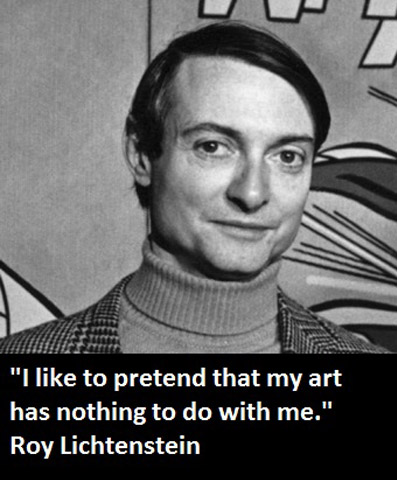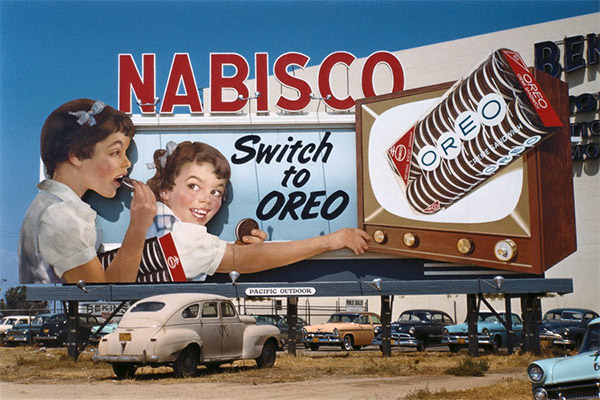The Postmodern era begins around the end of World War II, in 1945, and The Vietnam War: The Cold War, ‘55-’75. In the USA political and racial turmoil contribute to the reasons why Martin Luther King, President John F. Kennedy, and his brother Senator Robert F. Kennedy are assassinated. People learn to exchange naivety for harsh reality. Postmodern painting reflects trained artists’ responses. No longer dependent upon classical teachings, some artists begin to incorporate image-based commercial products and services. This collection of paintings illustrates the unleashing of artistic freedom.
Roy Lichtenstein (1923 – 1997) is a level-headed individual. His spectrum of experiences contributes to a dynamic life which begins and ends in the most densely populated borough of New York City, Manhattan Island.
In World War II, Roy serves by drawing up maps for planned troop movements. By the time he reaches forty, painting full-time takes the place of teaching at Universities. Ultimately, Lichtenstein is appreciated for the endless humor he expresses in paintings based upon his version of comic strip themes.
Roy’s art appears at the Venice Biennale, a major contemporary art exhibition that takes place every two years, in Italy. The Solomon R. Guggenheim Museum of Art, in New York City, exhibits his work repeatedly.
Lichtenstein’s versatility is evident when he emblazons this 77-foot yacht with a mermaid, for the most important sailing race - the America’s Cup, in 1995. The photo is Courtesy of Artnet.
A year before his death, Roy Lichtenstein accepts an Honorary Doctorate of Fine Arts from George Washington University, in Washington, D.C. Lichtenstein’s last commission is a clever, logo design consisting of musical notes for DreamWorks Records SKG.

Postmodern, Pop Art movement is one of the major art movements characterizing themes drawn from unexpected sources (c.1955 – 1970s). Billboards like this one clutter the landscape. The USA is suddenly awash in a mass culture of commercialism and consumerism.
Lip-curling, hip-shaking, Elvis Presley delivers a music genre called rock ‘n roll; the Beatles chime in, an American teen culture finds its voice. The rest of the world hops on the bandwagon.
Optimism surrounding the Post-World War II consumer boom is fueled by accumulated savings due to fewer places to spend. This conflicts with the harsh side, of crime, depression and strife concerning the ongoing Vietnam war.
“Free love“ begins in San Francisco, California, and spreads to the East coast. Unrestrained racism, in the ghettos of America, is overwhelming.
In 1966, the movement’s origin in Britain, and England’s part in the war effort may explain why London’s Tate Modern purchases the painting amidst older trustees’ opposition.

Go on to Describe, Analyze, Interpret & Conclude. Contact me for help.
Whamm! 1963. (Acrylic and oil paint on canvas. Support: 1727 x 4064 mm, frame: 1747 x 4084 x 60 mm—67 x 160 inches.) Diptych (two panels).
Tate Modern requires this caption: “Whamm! is based on an image from All American Men of War published by DC Comics in 1962. Throughout the 1960s, Lichtenstein frequently draws on commercial art sources such as comic images or advertisements. He transfers their highly emotional subject matter to a painting context using detached techniques. Lichtenstein presents powerfully charged scenes in an impersonal manner, leaving the viewer to decipher meanings for themselves.”
Serious renderings of Renaissance history paintings depicting men fighting in wars propels art critics to shift consciousness when they see Roy transpose the horrors of war into parody, trivializing the subject matter.
All the more surprising because Roy knows war first hand. His enthusiasts say he understands the premise of Pop art better than any other, for just this reason.
Lichtenstein adds ground pigments to acrylic paint to create a glossy finish. He uses projectors to magnify, and spray-gun stencils used in the printing industry. The Ben-Day Dots printing press technique after illustrator and printer Benjamin Day is frequently observed. His wife, friends, and Roy narrate the video, Roy Lichtenstein: Diagram of an Artist.